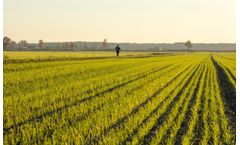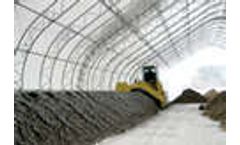Manure Applicator Articles & Analysis: Older
24 articles found
Costs can be prohibitive Custom contractors who do most manure spreading today are seldom set up for variable rate (VR) applications. ...
Tied-ridging had the highest positive effect on yield. A combined application of manure and inorganic fertilisers at either 5 or 10 t ha –1 plus 20 kg N plus 20 kg P 2 O 5 kg ha –1 had the most positive effect on yields. In the absence of inorganic fertilisers, a minimum of manure at 10 t ha –1 should be applied on maize. The ...
Increasing costs associated with inorganic fertilizer have led to widespread use of broiler litter. Proper land application, typically limiting nutrient loss, is essential to protect surface water. This study was designed to evaluate litter-borne microbial runoff (heterotrophic plate count bacteria, staphylococci, Escherichia coli, enterococci, and Clostridium perfringens) while applying ...
Water pollution from the land application of manure has been cited as an issue that needs to be addressed. ...
“Studies were conducted on nutrient management for the state to determine how many acres were available for manure spreading. Based on the results, which showed that there wasn’t enough land, we decided to investigate composting as an option for managing and exporting our nutrients.” Besides regulatory issues, the Jacquier family had several other interests in ...
We tested the efficacy of matrix-based fertilizers (MBFs) to reduce Escherichia coli and Enterococcus spp., NH4, NO3, dissolved reactive phosphorus (DRP), and total phosphorus (TP) in leachate and soil after dairy manure application in greenhouse column studies. The MBFs are composed of inorganic N and P in compounds that are relatively loosely bound (MBF8) to ...
(forage grain) with and without manure compost, and spring wheat-field pea (Pisum sativum L.)-spring wheat-flax (grain only), as well as a restored prairie grass planting (Prairie). Conventional treatments received synthetic fertilizers and herbicides whereas the Organic received no inputs other than a one-time application of manure compost. The ...
(forage grain) with and without manure compost, and spring wheat-field pea (Pisum sativum L.)-spring wheat-flax (grain only), as well as a restored prairie grass planting (Prairie). Conventional treatments received synthetic fertilizers and herbicides whereas the Organic received no inputs other than a one-time application of manure compost. The ...
Merr.) yields in a clay loam and sandy loam. The applications of PMS and DCM increased mostly N mineralization and crop yields in the sandy loam than in the clay loam. ...
For removal of phosphorus (P) from swine liquid manure before land application, we developed a treatment process that produces low P effluents and a valuable P by-product with minimal chemical addition and ammonia losses. ...
Runoff water following a rain event is one possible source of environmental contamination after a manure application. This greenhouse study used a rainfall simulator to determine bacterial-associated runoff from troughs of common bermudagrass [Cynodon dactylon (L.) ...
Excessive or N-based application of poultry manure for crops may result in significant risk of P loss with surface runoff. This study assessed P loss immediately after poultry manure application to soybean [Glycine max (L.) Merr.] residue with and without tillage at eight Iowa fields. ...
The amount of dietary P fed to dairy cows (Bos taurus) and the timing of a rain event after manure application may further affect runoff P losses. The objective of this study was to examine dietary P supplementation effects on manure and runoff P concentrations from rain events occurring at different time intervals after manure ...
In contrast, long-term application of manure significantly increased water-stable macroaggregates, potentially mineralizable nitrogen (PMN), and soil preseeding NO3–N levels. Corn yield and N uptake were increased by mineral fertilization compared to the control, and manure application increased corn yield by 89 and 87% and corn ...
Manure application in minimum till (MT) systems is a challenge worthy of attention because residue cover is a keystone for environmental protection. To develop a system combining zone tillage and manure application into one operation (zonejection), two experiments were conducted. In Exp. 1, liquid swine manure ...
No difference was detected for spring DM between CC no manure and manure treatments. Shoot DM, N, P, and K uptake increased 29, 41, 31, and 25% from the CC manure 112 to CC manure 224 with no increase above CC manure 224. Cover crop N uptake was higher in CC manure vs. no manure ...
Treatments included three crop rotations, with and without a history of organic amendment [solid beef (Bos taurus) manure] application: PB, potato-barley (Hordeum vulgare L.); PSPB, potato-soybean [Glycine max (L.) ...
Nitrogen mineralization and immobilization following manure application are critical processes influencing plant N supply and offsite N losses. ...
The use of urea fertilizers in grasslands is likely to increase in areas with concentrated animal feeding operations as restrictions on manure applications are implemented. Concerns have been raised about the economic and environmental impacts of NH3 loss from these urea fertilizers. ...
Understanding P and N dynamics in manure-amended soil is essential for estimating the environmental impact of manure utilization in land applications. ...





